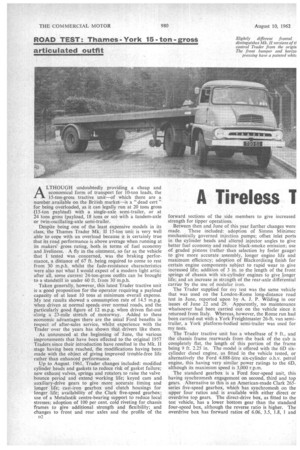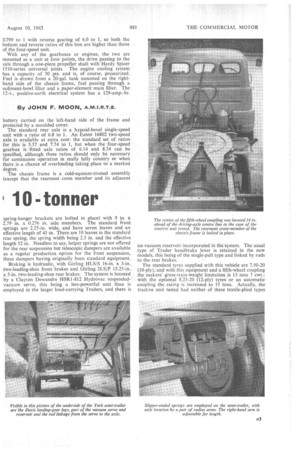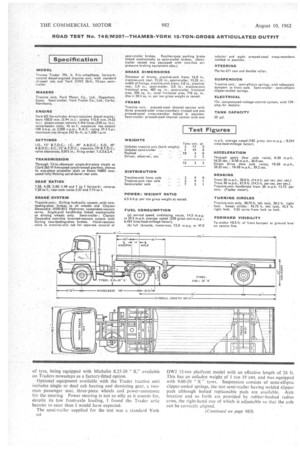A Tireless 10-tanner
Page 56

Page 57

Page 58

Page 63

If you've noticed an error in this article please click here to report it so we can fix it.
By JOHN F. MOON, A.M.I.R.T.E.
ALTHOUGH undoubtedly providing a cheap and economical form of transport for 10-ton loads, the 15-ton-gross tractive unit—of which there are a number available on the British market—is a "dead cert " for being overloaded, as it can legally run at 20 tons gross (15-ton payload) with a single-axle semi-trailer, or at 24 tons gross (payload, 18 tons or so) with a tandem-axle or twin-oscillating-axle semi-trailer.
Despite being one of the least expensive models in its class, the Thames Trader Mk. II 15-ton unit is very Well able to cope with an overload because it is certainly true that its road performance is above average when running at its makers' gross rating, both in terms of fuel economy and liveliness. A fly in the ointment, so far as the vehicle that I tested was concerned, was the braking performance, a distance of 67 ft. being required to come to rest from 30 m.p.h. whilst the fade-resistance characteristics were also not what I would expect of a modern light artic: after all, some current 24-ton-gross outfits can be brought to a standstill in under 60 ft. from 30 m.p.h.
Taken generally, however, this latest Trader tractive unit is a good proposition for the operator requiring a payload capacity of at least JO tons at minimum overall expense. My test results showed a consumption rate of 14.5 m.p.g. when driven at normal speeds over normal roads, and the particularly good figure of 12 m.p.g. when driven fiat-out along a 23-mile stretch of motorway. Added to these economic advantages there are the usual Ford benefits in respect of after-sales service, whilst experience with the Trader over the years has shown that drivers like them.
As announced at the beginning of June, the various improvements that have been effected to the original 1957 Traders since their introduction have resulted in the Mk. II stage having been reached, the modifications having been made with the object of giving improved trouble-free life rather than enhanced performance.
Up to August. 1961, Trader changes included: modified cylinder heads and gaskets to reduce risk of gasket failure; new exhaust valves, springs and rotators to raise the valve bounce period and extend working life; keyed cam and auxiliary-drive gears to give more accurate timing and longer life; cast-iron gearbox and clutch housings for longer life; availability of the Clark five-speed gearbox; use of a Metalastik centre-bearing support to reduce local stresses; adoption of 100 per cent. cold riveting for chassis frames to give additional strength and flexibility; and changes to front and rear axles and the profile of the 02 forward sections of the side members to give increased strength for tipper operations.
Between then and June of this year further changes were made. These included: adoption of Simms Minimec mechanically governed injection pumps; offset inlet ports in the cylinder heads and altered injector angles to give better fuel economy and reduce black-smoke emission; use of graded pistons (rather than selection by feeler gauge) to give more accurate assembly, longer engine life and maximum efficiency; adoption of Blackordising finish for certain engine components subject to rapid wear to give increased life; addition of 3 in. to the length of the front springs of chassis with six-cylinder engines to give longer life; and an increase in strength of the rear-axle differential carrier by the use of nodular iron.
The Trader supplied for my test was the same vehicle that was used on the London-Rome long-distance road test in June, reported upon by A. J. P. Wilding in our issues of June 22 and 29. Apparently, no maintenance whatsoever had been carried out on the vehicle since it returned from Italy. Whereas, however, the Rome run had been carried out with a York Freightmaster 26-ft. van semitrailer, a York platform-bodied semi-trailer was used for my tests.
The Trader tractive unit has a wheelbase of 9 ft., and the chassis frame rearwards from the back of the cab is completely flat, the length of this portion of the frame being 9 ft. 2.25 in. The model is offered with the 6D sixcylinder diesel engine, as fitted in the vehicle tested, or alternatively the Ford 4.888-litre six-cylinder o.h.v. petrol engine, this having very similar power ratings to the 6D, although its maximum speed is 3,000 r.p.m.
The standard gearbox is a Ford four-speed unit, this having synchromesh engagement on second, third and top gears. Alternative to this is an American-made Clark 265series five-speed gearbox, which has synchromesh on the upper four ratios and is available with either direct or overdrive top gears. The direct-drive box, as fitted to the test vehicle, has a lower bottom gear than the standard four-speed box, although the reverse ratio is higher. The overdrive box has forward ratios of 6.06, 3.5, 1.8, 1 and D.799 to -1 with reverse gearing of 6.0 to 1, so both the bottom and reverse ratios of this box are higher than those of the four-speed unit.
With any of the gearboxes or engines, the two are mounted as a unit at four points, the drive passing to the axle through a one-piece propeller shaft with Hardy Spicer 1510-series universal joints The engine cooling system has a capacity of 30 pts. and is, of course, pressurized. Fuel is drawn from a 20-gal. tank mounted on the righthand side of the chassis frame, fuel passing through a sediment-bowl filter and a paper-element main filter. The 12-v., positive-earth electrical system has a 129-amp.-hr.
battery carried on the left-hand side of the frame and protected by a moulded cover.
The standard rear axle is a hypoid-bevel single-speed unit with a ratio of 6.8 to 1. An Eaton 16802 two-speed axle is available at extra cost: the standard set of ratios for this is 5.57 and 7.74 to 1, but when the four-speed gearbox is fitted axle ratios of 6.14 and 8.54 can be specified, although these ratios should only be necessary for continuous operation in really hilly country or when there is a chance of overloading taking place to a marked degree.
The chassis frame is a cold-squeeze-riveted assembly (except that the rearmost cross member and its adjacent
spring-hanger brackets are bolted in place) with 9 in. x 2.79 in. x 0.276 in. side members. The standard front springs are 2.25-in, wide, and have seven leaves and an effective length of 45 in. There are 10 leaves in the standard rear spring, the spring width being 2.5 in. and the effective length 52 in. Needless to say, helper springs are not offered for the rear suspension but telescopic dampers are available as a regular production option for the front suspension, these dampers having originally been standard equipment.
Braking is hydraulic, with Girling HLS/S 16-in. x 3-in. two-leading-shoe front brakes and Girling 2LS/1) 15.25-in. x 5-in, two-leading-shoe rear brakes. The system is boosted by a Clayton Dewandre HSR1-812 Hydrovac suspendedvacuum servo, this being a less-powerful unit than is employed in the larger load-carrying Traders, and there is
no vacuum reservoir incorporated in the system. The usual type of Trader handbrake lever is retained in the new models, this being of the single-pull type and linked by rods to the rear brakes, The standard tyres supplied with this vehicle are 7.50-20 (10-ply),-and with this equipment and a fifth-wheel coupling the makers' gross-train-weight limitation is 13 tons 7 cwt.: with the optional 8.25-20 (12-ply) tyres: or an automatic coupling the rating is increased to 15 tons. Actually, the tractive unit tested had neither of these textile-plied types
of tyre, being equipped with Michelin 8.25-20 "X," available on Traders nowadays as a factory-fitted option.
Optional equipment aVailable with the Trader tractive unit includes single or dual cab heating and demisting gear, a twoman passenger seat, three-piece wheels and power-assistancc for the steering Power steering is not so silly as it sounds for, despite its low front-axle loading, I found the Trader artic heavier to steer than I would have expected.
The semi-trailer supplied for the test was a standard York n4 DW2 12-ton platform model with an effective length of 26 ft. This has an unladen weight of 1 ton 19 cwt. and was equipped with 9.00-20 " X" tyres. Suspension consists of semi-elliptic slipper-ended springs, the test semi-trailer having welded slipper pads although bolted replaceable pads are available. Axle location and so forth are provided by rubber-bushed radius arms, the right-hand one of which is adjustable so that the axle can be correctly aliened.
A Clayton Dewandre dual braking system was fitted, this Insisting of a single vacuum servo mounted in the chassis amc immediately behind the fifth wheel and linked to the 'ake units by rods, phis an air-pressure system with servo ;tinders mounted directly on the brake backplates. .Both these 'Quits were of the two-line type, the air-pressure side -of Which ould be familiar to many operators, but the two-line invertedxnum section being not so commonly used in this country. I met the test vehicle at the Chaseside Motor Co., Ltd:, afield (my local Ford main dealers), and the complete outfit is grossing exactly 15 tons with the cab empty, the individual ;le loadings being as detailed in. the accompanying data panel. us meant that the. imposed load on the trailer totalled I tons 4 cwt.—a quite high payload made possible by the irnmendably low unladen weights of the two parts of the itfit. Ford's Peter Johnson, who had been with this tractive tit on its Rome trip and who had driven it back to England so, 'accompanied ine during the test.
Lack of recent brake adjustment probably accounted for e rather lengthy stopping distances recorded from both m.p.h. and 30 m.p.h.. the average overall deceleration rates corded from each speed being virtually identical, No wheel eking took place during any of the tests, although there was ght marking of the road by the semi-trailer tyres. There was idence of some delay in the system, and rather high pedal ort was required to obtain the figures recorded. The marks am the semi-trailer tyres suggest that the York part of the alit was doing its stuff, therefore it must be assumed that E.. tractive-unit brakes were not powerful enough.
This was reflected by the tractive-unit's handbrake ,rformance also, stops from 20 m.p.Ft. using this brake alone odueing Tapley-meter readings of 11.5 per cent. and 16 per at„ using all the available handbrake-lever travel on each casion. Normally, 1 do stops from 20 m.p.h. using the semitiler brakes alone by actuation of the hand-reaction valve in e cab, but on this occasion I could not do so because the .nd valve is linked by cable to the inverted-vacuum reaction lye on the tractive-unit chassis, and every time I tried to use
• lever the cable nipple slipped out of its Slot in the lever: understand from A. P. Wilding that this occurred during e journey to Rome, so it is to be hoped that some irnproved zthod of linking the cable and lever will be deviSed soon_ As already intimated, good fuel-consumption figures were ■ tamed both under normal trunk-haulage conditions and on • Ml motorway When carrying out the normal-speed run e maximum speed of the outfit was restricted to about m.p.h., but when on the motorway full use. was made of all • available engine power and the Trader-York Was cruised close to its maximum speed of 51 m.p.h.
The acceleration times recorded were also good, and indicate at the gear ratios of the test vehicle matched the engine. aracteristics admirably. The standing-start tests were made th the low ratio of the axle engaged the whole time using :and, third, fourth and top gears. whilst fifth-low Was mloyed for the direct-drive tests, some transmission roughss being evident between 9 m.p.h. and 12.5 m.p.h. while sing these latter figures. Maximum-speed cheeks in the eight ratio combinations between second-low and • top-high were: 9, 13, 1.7, 23, 27, 37, 40 and 51 m.p.h.
Hill-performance tests were carried out in an ambient temperature of 17° C. (63° F.) on Bison Hill, this 0.75-milelong climb having an average gradient of I in 10.5. Fast hill climbing was shown by the ability to complete the ascent in 5 minutes 35 seconds, of which time 1 minute 52.5 seconds was Spent in bottom-high. The road speed never fell below 5 m.p.h., but when pulling hard I observed a certain ahlount of exhaust Smoking, this occurring on a vehicle which had coVered less than 5,000 miles. The climb caused the engine.Coolant temperature to rise from 79.5° C. (175' F,) to 85" C. (185° F.), a very reasonable increase.
The descent of the hill made in neutral to. test the faderesistance characteristics of the brakes occupied 2 minutes 36 seconds, and at the bottom of the hill a simulated crash stop from 20 m.p.h. produced a Tapley-meter reading of 0.35g.---a reduction of 0.27g over the maximum efficiency obtained earlier in the day. This is a rather high degree of fade for a vehicle of only 15 tons gross weight, and was accompanied by noticeable increase in pedal travel and required pedal effort.
Stop and restart tests were made both facing up and facing down the steepest -part of Bison Hill, the gradient of which is I in 6.5.. Facing up this slope, it was shown that the tractiveunit handbrake was not powerful enough to restrain the vehicle from rolling backwards, even after it had been helped on by the footbrake. The ratchet-type parking brake of the semitrailer would not hold the vehicle when applied by itself, although both the parking brakes applied together proved just powerful enough—but even then only after I had applied the footbrake first to help the other brakes on. Following this I just managed to make a restart in bottom-high (the same ratio combination that this part of the hill had been surmounted in when making the non-stop climb).
Facing down the hill, the tractive-unit handbrake held the outfit, again only after the footbrake had been applied, but the semi-trailer brakes were powerful enough by themselves and without needing the assistance of the footbrake, There was only just enough power for a restart in reverse-low.
So far as handling is concerned, the Trader attic was about average in this respect, although the steering was on the heavy side. Castor action was fairly pronounced and the steering was steady enough at high speed, with very little transference of road shocks to the wheel rim. Besides being rather heavy, the brake-pedal action felt dead, and even under normal braking conditions delay could be felt quite plainly.
Compared with other short-wheelbase tractive units, the Trader gave a rather rough ride, my impression being that much of this harshness cattle from the driving axle although the loading on this axle was close to the designed figure. A certain amount of semi-trailer " tugging " could be felt at times also. Another unfortunate effect that became apparent when applying the brakes fairly hard at speeds of over 35 m.p.h. was pronounced vibration of the front axle.
The engine-noise level in the cab was acceptably low, and it never became necessary to shout across the cab when conversing with Peter Johnson. Gear changing, with both the gearbox and the two-speed axle, was at all times good. This was just as well, as the ratios have to be used fairly energetic-,, ally, even on a motorway, to get the best performance.
The driving-seat cushion, however, is rather low, with the result that the driver tends to have to read' up a bit to hold the steering wheel, besideshaving a slightly reduced range of forward vision: a higher cushion position should effect asatisfactory compromise. However, the general standard of cab finish was high
The Thames Trader Mk. II 9-ft.-whee1base diesel-engined tractive unit with 8.25-20 (12-ply) tyres retails at £1,05110s., extras fitted to the lest vehicle including the five-speed gearbox (£85), two-man passenger seat (i5) and heating and demisting. equipment (single. £12; dual, £21). The 8.25-20 ." X" tyres
add 10s, The York DW2,26-ft. 12-ton semi-trailer, with flat platform body, vacuum brakes and 9.00-20 tyres has a basic, price of £868. a dual braking system, such as was fitted to the semi-trailer tested, adding £93 to this figure: The York fifthwheel coupling adds a further £82 to the overall price of the outfit, plus a net fitting charge of £10.
















































































































